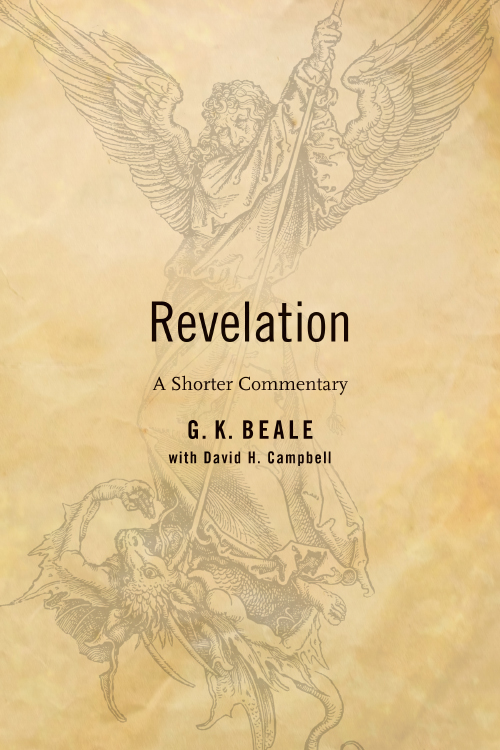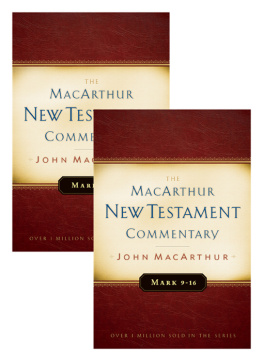
REVELATION
A Shorter Commentary
REVELATION
A Shorter Commentary
G. K. Beale
with David H. Campbell
W ILLIAM B . E ERDMANS P UBLISHING C OMPANY
G RAND R APIDS, M ICHIGAN / C AMBRIDGE, U . K .
2015 G. K. Beale and David H. Campbell
All rights reserved
Published 2015 by
Wm. B. Eerdmans Publishing Co.
2140 Oak Industrial Drive N.E., Grand Rapids, Michigan 49505 /
P.O. Box 163, Cambridge CB3 9PU U.K.
www.eerdmans.com
Library of Congress Cataloging-in-Publication Data
Beale, G. K. (Gregory K.), 1949
Revelation: a shorter commentary / G.K. Beale, with David H. Campbell.
pages cm
ISBN 978-0-8028-6621-9 (pbk.: alk. paper); ISBN 978-1-4674-4201-5 (ePub); ISBN 978-1-4674-4167-4 (Kindle)
1. Bible. Revelation Commentaries. I. Title.
BS2825.53.B43 2015
228.07 dc23
2014031223
Scripture quotations are, unless otherwise indicated, from the NEW AMERICAN STANDARD BIBLE, Copyright 1960, 1962, 1963, 1971, 1973, 1975, 1977, 1995 by The Lockman Foundation (www.Lockman.org). Used by permission.
Contents
In 1999 Eerdmans published my commentary titled The Book of Revelation in the New International Greek Testament Commentary series. Since the publication of the commentary I have heard continual requests that I write a shorter commentary on Revelation that would be more accessible for pastors, students, and Christians in general. So, after fourteen years I have decided to respond to these requests. The present shorter commentary on Revelation is the result. G. K. Chesterton once remarked, Though St. John the Evangelist saw many strange monsters in his vision, he saw no creatures so wild as one of his own commentators (Orthodoxy [New York: John Lane, 1908; repr. San Francisco: Ignatius, 1995], 21-22). It is my hope that Chesterton would not include my 1999 commentary nor this shorter one in this assessment.
When embarking on the task of commentary writing, one often asks oneself whether it is really necessary to write another commentary. In the case of Revelation, I believed back in the late 1980s there was still a need for a commentary which did the following things: (1) study the Old Testament allusions in a more trenchant manner than previously; (2) study how Jewish exegetical tradition interpreted these same Old Testament allusions and how such interpretation related to the use in Revelation; (3) trace more precisely the exegetical argument in Revelation, which some say is difficult to do because of the sometimes ambiguous nature of visionary literature; (4) interact with the vast amount of secondary literature published since the time of the monumental commentaries by Charles and Swete in the early part of the twentieth century. My intention in writing the commentary was to provide an exegesis of Revelation that would be especially helpful to scholars, teachers, pastors, students, and others seriously interested in interpreting Revelation for the benefit of the church. This was also a commentary on the Greek text of Revelation, though I usually provided English translation in parentheses after Greek words or phrases in order that those who were not proficient in Greek would nevertheless be able to benefit from reading the commentary.
However, in this shorter commentary I have for the most part eliminated references to Greek, references to secondary literature, and references to and discussion of Jewish interpretations of OT passages that are used in Revelation. Accordingly, there are ideas in this commentary for which there are no references to primary and secondary literature. Those references appear in the longer commentary, which can be consulted by those wanting more substantiation of what I say here. Ultimately, the longer commentary serves as one big footnote to this shorter commentary. Nevertheless, I have kept a focus on discussion of many of the OT allusions that were included in the original, though without most of the Greek verbal basis for the allusions. I have also preserved most of the important exegetical argument throughout Revelation
The most obvious difference is that this shorter commentary is much shorter than the original. The small font single-space excurses have been cut out from the original commentary and the essential content and argument from each chapter have been preserved in revised form. Some nuances of interpretation and options in the interpretation of problem texts have not been kept; the focus is now on the most probable interpretive alternatives.
I have not attempted to interact with secondary literature published since the appearance of my commentary in 1999, since my intent has been even to cut out most of the secondary literature references from the original. Indeed, this shorter commentary is longer than most shorter commentaries, and to have tried to engage much of the secondary literature published since 1999 would have only made it longer yet. Furthermore, while some of my interpretations of particular passages would be influenced by some of this subsequently published material, my overall argument and the essential substance of the commentary would not be significantly altered. Finally, engaging with subsequent secondary literature would not be suitable for the purpose of this shorter commentary: to make my first commentary more accessible to pastors, students, and Christians in general.
A special word to preachers and teachers: the full-sentence titles at the beginning of each major section or subsection of the commentary represent the exegetical conclusions of that section and can serve as the basis of homiletical ideas. And for all readers of this shorter commentary, in addition to my longer commentary in the New International Greek Testament Commentary series (1999), I recommend the following commentaries and other works on Revelation as particularly helpful. Some are serious works of scholarship and some are more popular works.
Richard J. Bauckham. The Climax of Prophecy: Studies on the Book of Revelation. Edinburgh: T. and T. Clark, 1993.
. The Theology of the Book of Revelation. Cambridge: Cambridge University Press, 1993.
G. B. Caird. A Commentary on the Revelation of St. John the Divine. London: A. and C. Black; New York: Harper and Row, 1966.
Colin J. Hemer. The Letters to the Seven Churches of Asia in Their Local Setting. Sheffield: JSOT, 1986.
William Hendriksen. More Than Conquerors: An Interpretation of the Book of Revelation. Grand Rapids: Baker, 1962.
Alan F. Johnson. Revelation. Expositors Bible Commentary 12; Grand Rapids: Zondervan, 1981, 397-603. Published separately, 1996.
Dennis E. Johnson. Triumph of the Lamb: A Commentary on Revelation. Phillipsburg: Presbyterian and Reformed, 2001.
Martin Kiddle, with M. K. Ross. The Revelation of St. John. Moffatt New Testament Commentary; London: Hodder and Stoughton, 1940.
R. H. Mounce. The Book of Revelation. New International Commentary on the New Testament; Grand Rapids: Eerdmans, 1977.
Grant R. Osborne. Revelation. Baker Exegetical Commentary on the New Testament; Grand Rapids: Baker, 2002.
Vern S. Poythress, The Returning King: A Guide to the Book of Revelation. Phillipsburg: Presbyterian and Reformed, 2000.
Stephen S. Smalley. The Revelation of John: A Commentary on the Greek Text of the Apocalypse. Downers Grove: InterVarsity, 1979.
J. P. M. Sweet. Revelation. Philadelphia: Westminster; London: SCM, 1979.
M. Wilcock.
Next page
















